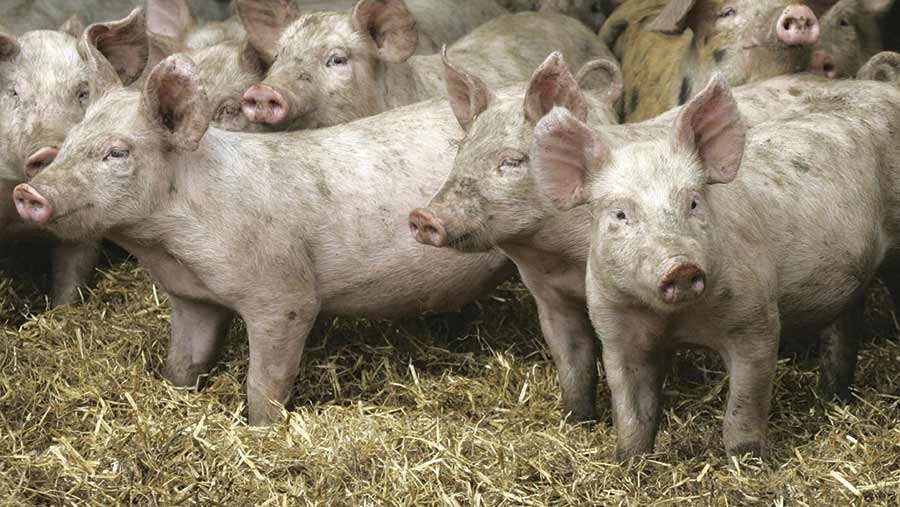Trial reveals benefits of feeding pigs rye
 © Tim Scrivener
© Tim Scrivener Rye could be used as a cost-effective substitute for wheat in pig rations and offer health and welfare benefits too, a recent trial at Bishop Burton College has demonstrated.
Pigs fed rye also demonstrated less aggressive behaviour and had higher daily liveweight gains of 0.06kg a day on average.
The trial was carried out as a joint project by plant breeder KWS, Bishop Burton College and agronomy specialist Agrii. A batch of more than 100 pigs, weighing 60kg at the outset, was split into two groups. One was fed a complete compound, which included a winter hybrid rye variety, and the other group was fed a standard, wheat-based compound.
See also: Danish pig farmer cuts costs and improves animal performance with feed swap
Inclusion rates, observations and results
Danish research has led to a recommended rye inclusion rate of up to 20-25% in weaner diets and up to 60% in finisher diets. It can also be used at a maximum of 20% for piglets and 30% for sows. As the pigs at Bishop Burton had not previously been offered rye, a small quantity of wheat was added to the mix to ease the dietary transition, with the total rye inclusion set at 30%.
Pig behaviour was monitored for 30 minutes daily by a Bishop Burton student for eight weeks, with unwanted behaviour such fighting for food, biting and nose charging individually noted.
Results showed:
- The pigs on the rye diet achieved an average DLWG of 1.13kg compared to 1.07 for the group fed wheat, although other European trials with higher rye inclusion levels have indicated that the two cereals have similar performance potential.
- Fighting over food almost halved within the rye group and biting, nosing, charging and nipping was also markedly reduced.
Researchers believe rye left the pigs feeling fuller for longer and therefore less prone to exhibiting aggression.
“Rye has a high fibre content, which means it takes longer to be consumed by the pig and occupies more of its time, easing boredom,” says Rose Riby of KWS. “This is thought to be the reason why a reduced level of unwanted behaviour was recorded by the observers. In Denmark, post-mortem results have also shown a lower incidence of gut ulceration, possibly due to the additional fibre.
“We believe that rye is at least equal to wheat, in terms of economic performance, and the behavioural study was very encouraging. Several UK pig farmers are growing hybrid rye with the intention of test trial feeding in home mixer diets and we will be following their progress when it is fed out,” says Miss Riby.
How rye compares to other cereals
With an average ME of 13.5 MJ/Kg, rye is positioned just below wheat (14.2 MJ/Kg) and above barley (12.9 MJ/Kg). It characteristically contains a higher lysine to protein ratio than wheat, barley or oats. Rye also has the highest fructan content of all cereals.
In monogastrics, fructan is converted into butyrate, after being digested in the hind gut. Butyrate is thought to limit the release of the chemical, skatole, which has been linked to boar taint. In addition, the greater absorption of butyrate by pigs fed on rye has been associated with a reduced risk of salmonella infection.
Input costs for growing rye are typically 20-30% lower, compared with wheat, partly due to its reduced nitrogen requirement of 130-160kg/ha. Rye also has low susceptibility to the soil-borne disease take-all. The only cereal with a higher resistance score is oats. Unlike wheat or barley, rye is a cross-pollinating species and this has historically increased the risk of ergot.
In trials at the KWS site near Malton in North Yorkshire, rye exceeded average winter wheat yields by 0.7t/ha and produced an increase of 2.5kg/hl in specific weight, when substituted for a second wheat. It also has extreme winter hardiness and high drought tolerance, as well as being suitable for all soil types, especially light land. It is characteristically taller than most wheats, offering a greater opportunity to out-compete blackgrass.
